Is diversification the key to recovery for Alberta and Saskatchewan businesses?
It’s been a tough year for entrepreneurs in Alberta and Saskatchewan with the economy taking a double hit from the COVID-19 pandemic and a sharp drop in energy prices.
Many entrepreneurs are looking to get back on a growth track. A new survey by our team at BDC suggests the best way to do that is by combining tech investment with a strategy to diversify your business activities through such strategies as finding new markets and launching new products and services.
In this blog post, I will talk about how diversified businesses did better during the crisis. In my next blog post, I will explain why it should be done in combination with investment in digital technologies.
Diversification: A good risk mitigation strategy
By diversifying your business, you will reduce your dependency on one big client, line of products or geographic markets to generate revenue and grow. It is about mitigating risks for your business, your clients and your employees.
Here are some business risks you can prevent by diversifying your activities.
Overreliance on a single client or city
Many companies depend on a single customer or client to the point where the loss of this client would dramatically affect the entire business. Similarly, operating in only one city or town can expose you to significant risk if there is a major downturn in that area. Diversifying your client base and your area of operation will improve your resiliency.
Concentrating on a single product or service or operation in only one sector
You can have many clients in many cities, but if you depend on only one product or service, you could be exposed to “obsolescence risk”—the risk that your products or services will no longer be marketable because of changes in tastes or technology.
The same problem applies if you only sell in one sector of activity. Your fortunes are tied to the sector in which you operate, exposing you to the risk of a sudden contraction in the sector’s activity or, worse, its long-term decline. You can reduce risk by broadening the scope of your offering.
Operating in a single location
While your customers may not all be located in the same area, your business may be constrained by a heavy dependence on a single location for office and factory space, foot traffic (e.g., for retailers) and skilled labour. If that’s the case, your business runs the risk of being isolated from the rest of the world, for example in the event of a natural disaster—or even just roadwork—that could limit or cut off access to your business.
If your company only sells and operates within Canada, you company faces a similar risk. Your fortunes will depend heavily on Canada’s economic performance and faces the risk of increasing competition from foreign firms entering your market. Pursuing a market diversification strategy by having multiple locations in Canada and abroad reduces these risks.
Diversified businesses are more likely to be high growth
The survey of 500 business owners and decision-makers in Alberta and Saskatchewan found that diversified companies were twice as likely to have experienced high revenue growth (over 10%) during the previous year.
Overall, 16% of businesses that were diversified—by expanding into new markets, launching new products and services, or growing their customer base—achieved high growth, despite a difficult year for the region. This compares to just 8% of undiversified businesses that achieved high growth.
Overall, 16% of businesses that were diversified […] experienced high growth. […] This compares to just 8% of undiversified businesses that achieved high growth.
Among diversified businesses, those that pursued a market expansion strategy by selling outside of Canada or setting up operations in more than one Canadian city were three time more likely to experience high growth than their peers (23% vs 8%).
We also notice that a slightly larger proportion of businesses that diversified their offering were high growth. These businesses are characterized by that fact that they don’t depend on a single product or service for more than a fifth of their revenue and they serve more than one sector.
A surprising, though not statistically significant result, is that businesses with a diversified customer base were a little less likely to have experienced high growth than those who did not have a diverse customer base. This could be due to the unprecedented severity of the COVID-19 crisis. Since most firms experienced a negative shock, having a diversified client base did not help to mitigate the negative impact of the crisis.
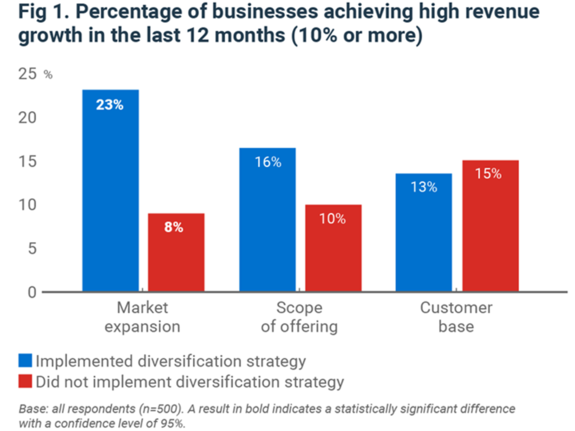
Besides being more likely to grow revenues, diversified businesses tended to be more innovative—a key to increasing your company’s competitiveness. The survey found that 73% of leaders in diversified businesses said they had introduced an innovation over the prior year, compared to 57% for undiversified businesses.
Market expansion and increasing the scope of offering remain a challenge
Although many companies in the region continue to be exposed to the oil prices, two-thirds of respondents have diversified in at least two ways, with large firms being more likely to have done so. Businesses tended to be well diversified in terms of their customer base but lagged on market expansion efforts and broadening the scope of their offerings.
It’s interesting to note that market expansion was the strategy most closely associated with high growth, yet it was the least popular diversification strategy for firms in the region.
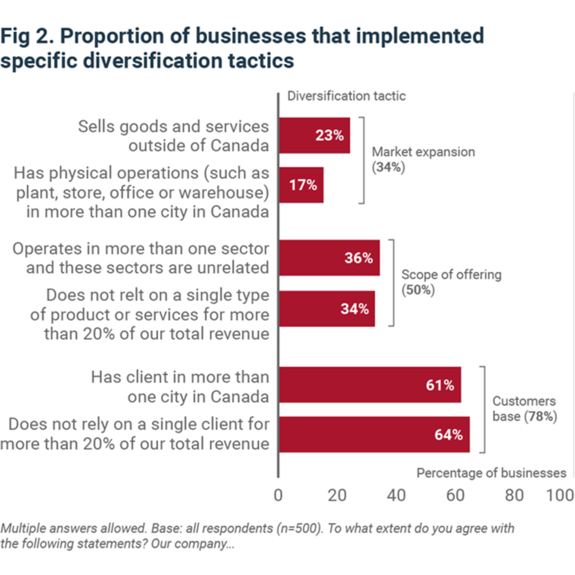
By far, the top reasons given by entrepreneurs for wanting to diversify were a desire to remain in business, find new ways to grow and expand their markets.
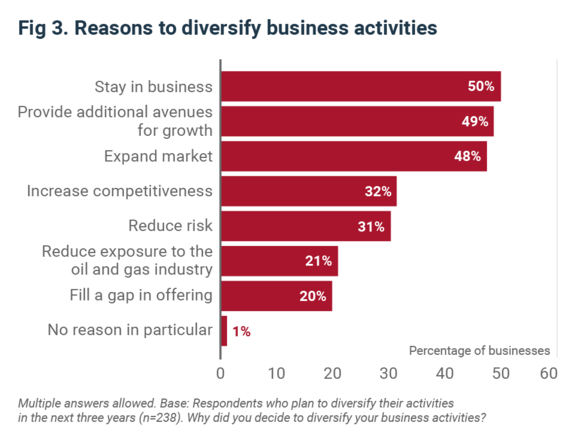
Survey findings backed up by earlier study
The benefits of diversification suggested by the survey are supported by the findings of a 2015 study we conducted in the wake of an earlier collapse in oil prices. That study, based on a survey of nearly 1,000 Alberta businesses, found that diversification—whether by product, geography or number of customers—correlated strongly with financial success.
It also found that the most diversified businesses were by far the top performers and even somewhat diversified firms were likely to outperform those that are undiversified. Even modestly diversified businesses outperformed their less-diversified counterparts and the most diversified firms experienced by far the fastest growth in revenue and profits.
A continuing reliance on the energy industry
The recent survey shows many businesses in Alberta and Saskatchewan continue to rely on the oil and gas industry, with 47% of respondents reporting that 20% of or more of their revenues directly or indirectly come from the sector. Larger companies, defined as those with over $10 million in annual revenue, were significantly more exposed to oil prices. The survey found 72% of large companies in Alberta and Saskatchewan had been negatively affected by the drop prices.
47% of respondents reported that 20% of or more of their revenues come directly or indirectly from the oil and gas sector.
However, it also indicates many entrepreneurs have gotten the message that diversification can open the door to stronger growth. Nearly half of the business owners (46%) said they intend to diversify over the next three years as the economy emerges from the current recession and growth resumes.
Fully 63% of respondents who intend to diversify said they want to increase their customer base while 57% said they intend to introduce new products or services. Market expansion initiatives are the least considered tactics for entrepreneurs in the region, which is unfortunate since our data seems to indicate that they hold the most potential for growth.
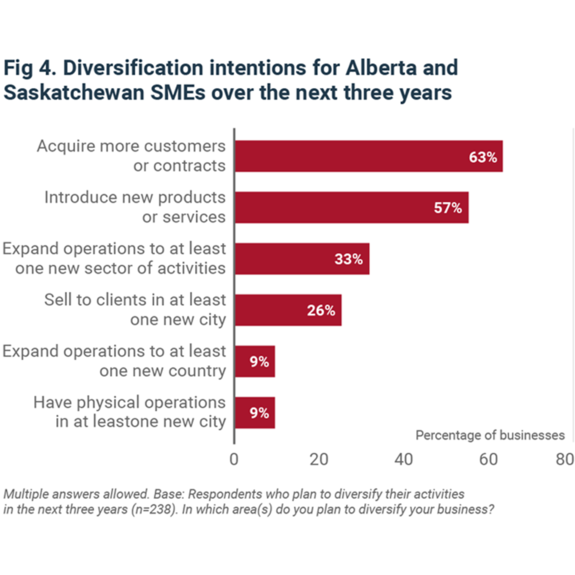
Business acquisitions and the cleantech sector are promising avenues for diversification
Many entrepreneurs also said they’re looking to diversify by acquiring another company—a promising strategy at a time when more companies may be coming up for sale, either because of financial distress or because their owner is retiring. The survey found 36% of respondents planned to buy another business with entrepreneurs in mid-sized cities and those in the manufacturing industry most likely to be considering this route.
We also found that close to 24% of businesses that are exposed to the oil and gas industry are definitely planning to diversify into the cleantech industry while another 42% are considering doing so. Cleantech refers to delivering products and services that improve operational performance, productivity or efficiency, and reduce inputs, energy consumption, waste or environmental pollution.
Pandemic and oil price collapse have taken a heavy toll
Not surprisingly, the survey found many Alberta and Saskatchewan entrepreneurs are not in a confident mood given this year’s challenges.
Only about one-third of entrepreneurs said they are feeling optimistic about their company’s performance in the next year. Over half (59%) said they had been negatively impacted by falling oil prices and an even higher number (75%) had been negatively impacted by the pandemic.
Only about one-third of entrepreneurs said they are feeling optimistic about their company’s performance in the next year.
As a result, three-quarters of the entrepreneurs said they’ve seen a drop in their sales and more than 40% said they had fewer employees on the payroll. About a third said they are facing higher operating costs and indebtedness.
In a time of economic turbulence and uncertainty, entrepreneurs said finding new clients and markets was by far their biggest challenge in diversifying their business.
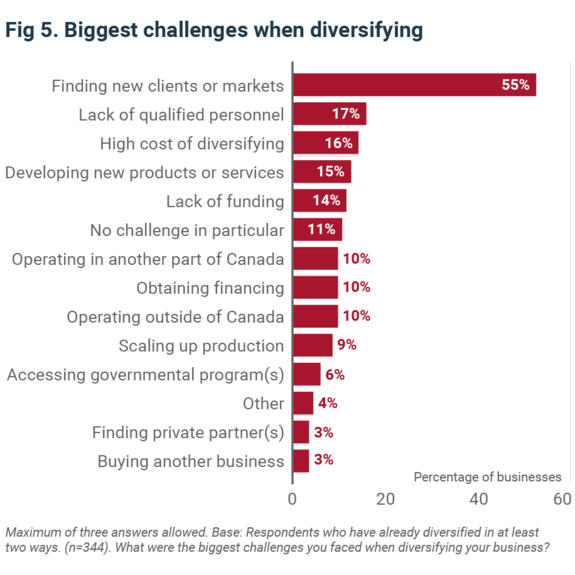
A stronger business in good times and bad
The bottom line is that diversification—including opening new markets and launching new products—should be a central goal in your business’s strategic plan as you navigate out of the recession.
By securing a variety of sources of revenue and profit, you will build company that’s not only grows faster when times are good, but is also more resilient when they turn bad.
Of course, combining your diversification strategy with tech investment can help maximise profit. Read my next blog post to know how.